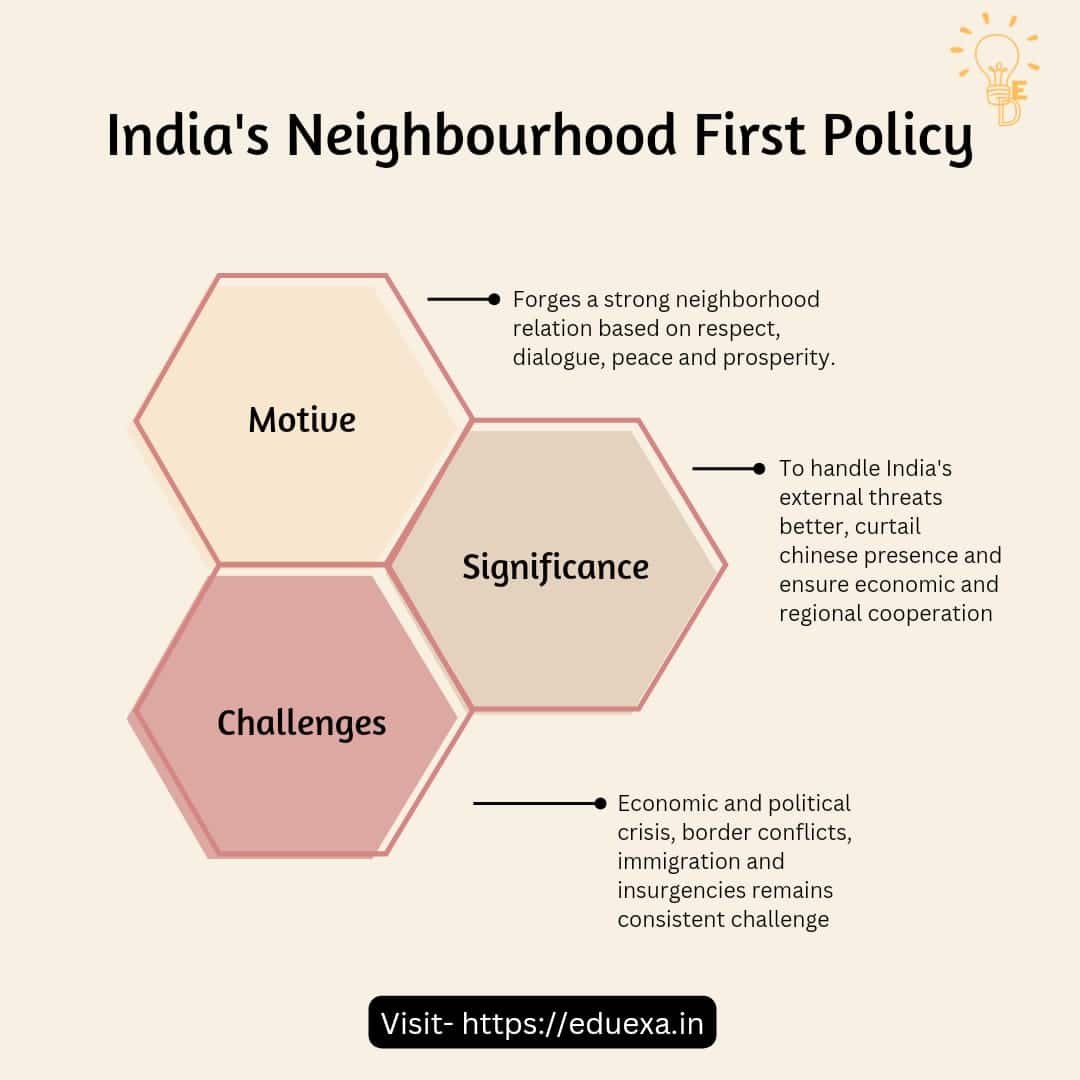India’s Neighbourhood First Policy: A Complete guide in 2024
What is India’s neighbourhood first policy?
The Policy aims to establish a strong neighbourhood relation based on a consultative, non-reciprocal, outcome-oriented approach with India’s Neighbours.
It uses the principles of Samman (respect), Samvad (dialogue), Shanti (peace), Samriddhi (prosperity) and Sanskriti (culture) for better engagement.
Significance of Neighborhood First Policy
1. The policy is required to handle India’s external threats better. With an effective engagement with neighbouring countries, security threats such as insurgency and terrorist activities can be effectively prevented and contained.
2. Improve connectivity – Regional connectivity and cooperation is essential to foster growth and development in the region. It also ensures a free flow of resources, energy, goods, labour, and information across borders.
3. Promote economic and regional cooperation – Leveraging regional platforms like BIMSTEC and SAARC can provide opportunities for broader cooperation and help address common challenges.
4. To achieve the necessary support in multilateral forums like the UN, WTO etc. goodwill building is necessary.
5. In order to curtail Chinese dominance in the region and ensure significant presence of India.
6. Reduce Trust Deficit with neighbouring countries – India can reduce its trust deficit and address the sensitivities of small states through effectively engaging with them.
India’s initiative in neighbourhood
Infrastructural Projects –
Greater Male connectivity Project in Maldives
Road from Delaram to Zaranj in Afghanistan was completely funded by India.
Hydropower Projects
The Government of India has constructed Chukha HEP, Kurichu HEP and Tala HEP in Bhutan.
Project West Seti in Nepal is initiated.
Humanitarian Assistance
Providing vaccine doses under Vaccine Maitri initiative
Operation Maitri in Nepal during earthquake
Developmental Assistance
India has provided assistance to Bhutan’s five year plan.
Financial Assistance
India has extended financial grants to Sri Lanka.
Currency swap agreement with Sri Lanka and Maldives.
Challenges pertaining to India’s Neighbourhood
Volatility in the neighbourhood:
Any internal disturbance in the neighbourhood manifests its effect in terms of bilateral relations.
Ex: Myanmar’s military junta rule and disturbances may cause disturbances in borders.
Pakistan is facing a crisis in their administration which may lead to an increase in migrants to India.
Economic Crisis:
Economic disturbances and crises affect the consumer base and potential export market.
Ex: Sri Lanka and Pakistan facing hyper-inflation rates after the pandemic which has affected trade with India.
Border issues:
Border disputes remain a significant challenge to India’s Neighbourhood First Policy
Ex: Kashmir dispute with Pakistan
Dispute over Kalapani with Nepal
Maritime disputes persist with Pakistan and Bangladesh.
Infiltration and immigrant issue:
Extremists and illegal immigrants enter through the porous borders of Pakistan, Bangladesh and Myanmar.
Drug Trafficking
Close proximity to golden crescent and golden triangle countries increases India’s risk regarding drug and human trafficking cases.
Sharing of River water
Indus and Teesta water sharing is a significant issue with Pakistan and Bangladesh, respectively.
Way forward
India’s Neighbourhood First Policy should be based on Gujral Doctrine which is based on generous efforts without any expectations of reciprocation.
Improving the border infrastructure:
More Integrated Check Posts (ICPs)/Land Customs Stations (LCS) and border haats should be built.
Improving people-people connect:
Encouraging tourism and sharing of the bonds of common culture and history across the neighbourhood.
Resolving maritime and border disputes
India should focus on resolving conflicts with Bangladesh regarding Teesta Water Agreement to set an example as a responsible upper riparian country.
Resorting to cultural and soft diplomacy
Historical cultural connect between the people is an essential advantage with India which can be further used to achieve stable and peaceful relationships with countries like Nepal, Bangladesh, Sri Lanka etc.
Keeping diplomatic doors open with all neighbouring countries to resolve any arising issues. Continue the already taken steps like humanitarian assistance, implementation of developmental projects, Lines of Credit.
The neighbouring countries are bonded by factors like history, culture, language and geography so having cordial relationship with them is essential for better growth, development and ensuring peace.
What is UR Category? Read Complete Guide Here.




Pingback: UPSC Practice Questions Prelims 2024 -Eduexa
Pingback: Black Sea Grain Initiative UPSC: A Complete Guide in 2024